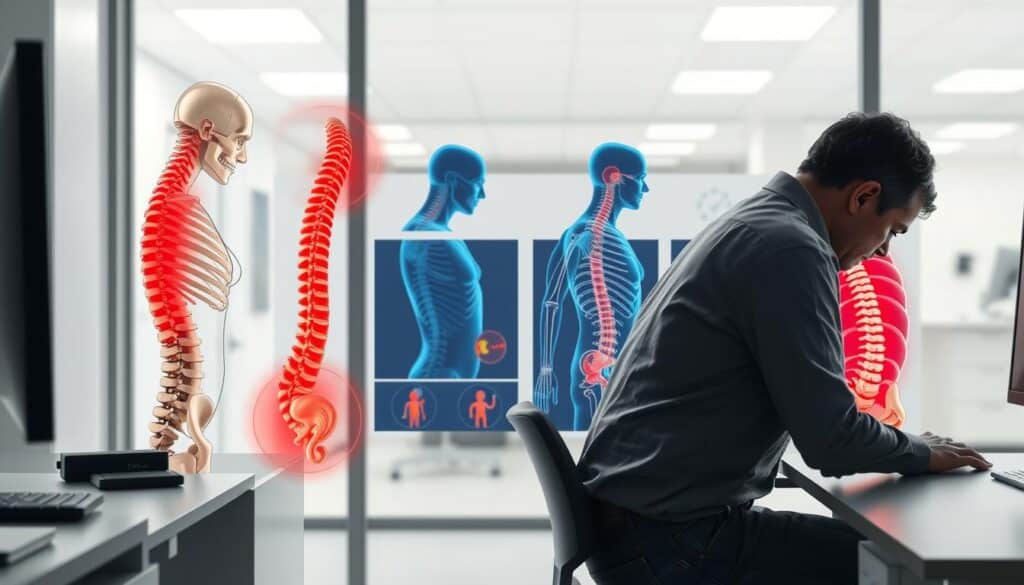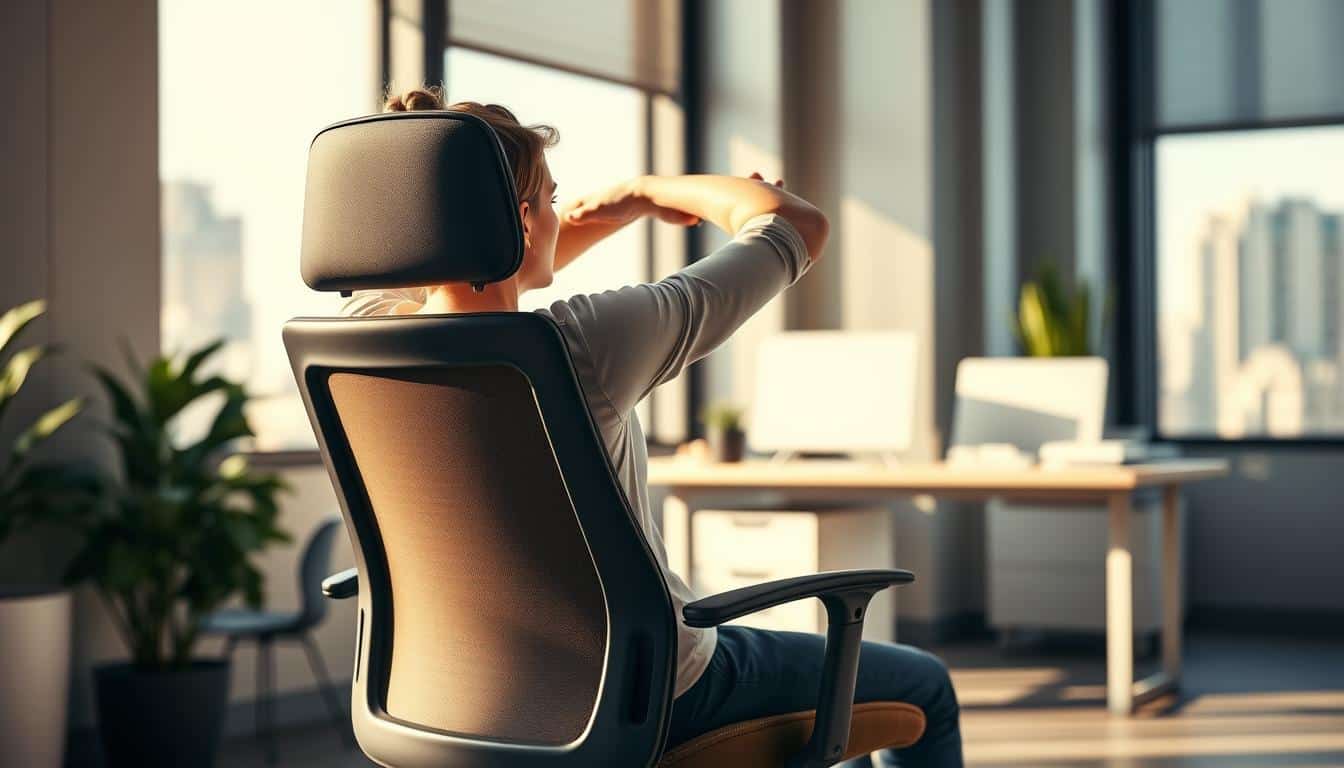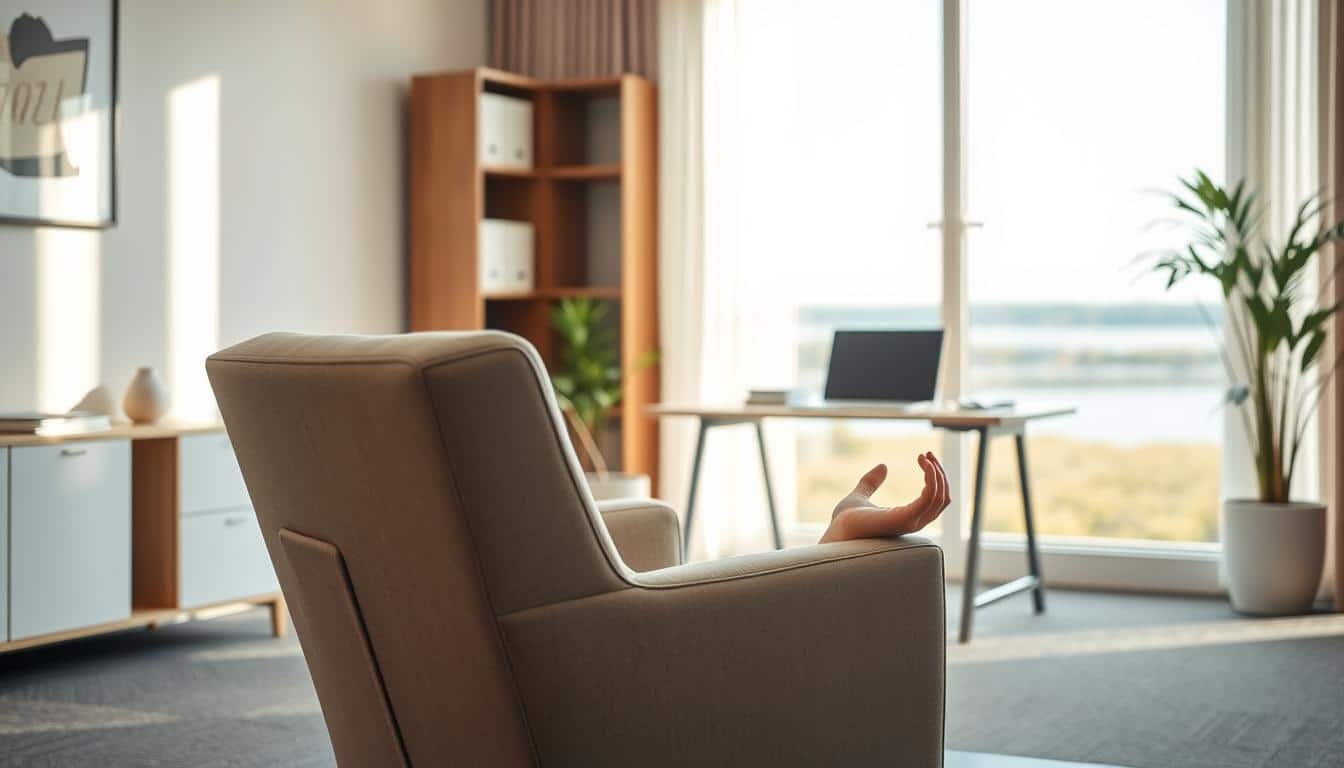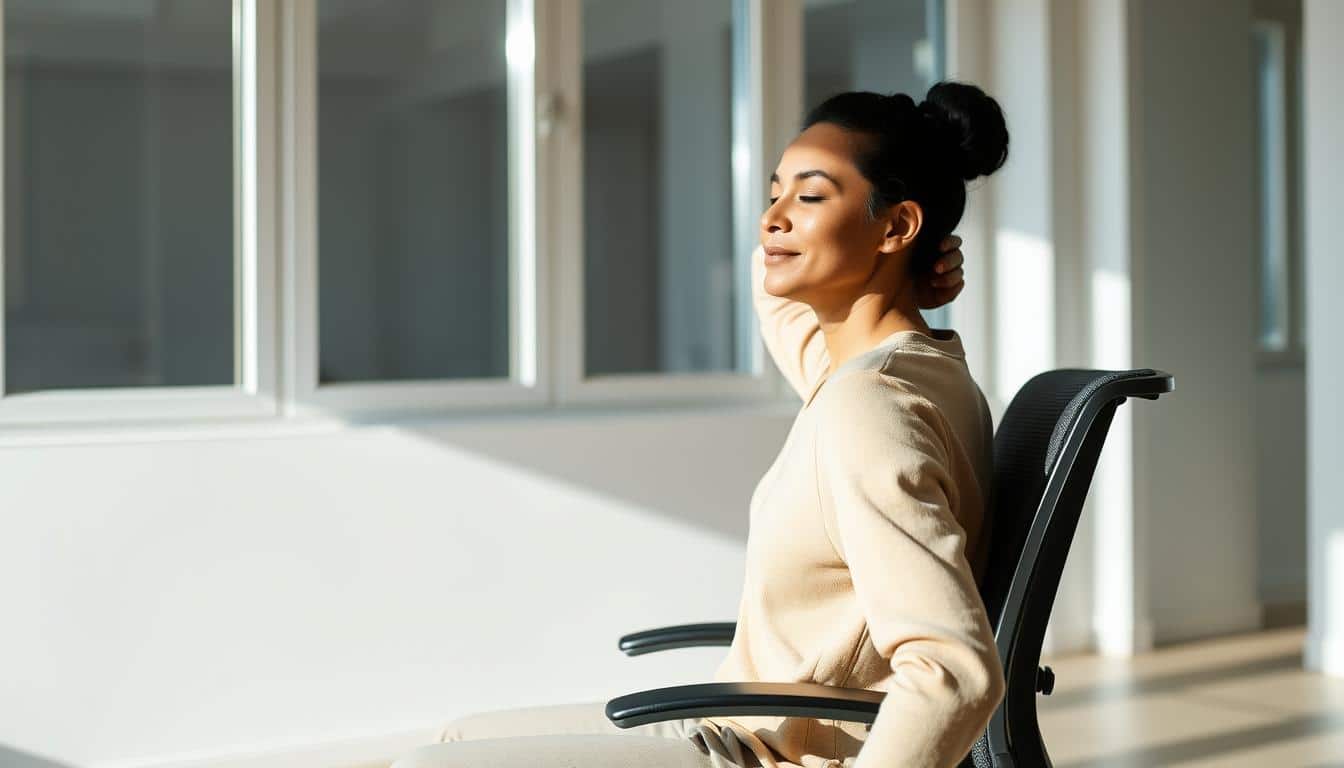Nowadays, we need to fix our posture more than ever due to our fast-paced work lives. Active sitting solutions can greatly better our posture, health, and productivity. Studies show these chairs can cut lower back pain by half compared to regular office chairs. They’re made to help you move more, which improves blood flow and helps your spine stay aligned. This can lead to big health benefits over time.
Active sitting lets you move in many directions. This helps get rid of waste in your spine, lowering the chance of back pain. Using something like the CorePerch by CoreChair, with its special seat, helps keep you aligned and moves your body right. Whether you’re sitting higher on active stools or using ergonomic chairs, adding movement is key. It keeps your upper body and hips stable.
By using active sitting, you can get stronger core muscles and better concentration. It also helps you burn more calories and keeps your blood flowing well. This fights the dangers of sitting too much. Discover how active sitting can change your work area and boost your health for a long time.
The Importance of Posture in Daily Life
Posture is very important in daily life. It affects how we look and feel. Keeping the right posture helps reduce pain and prevents problems with muscles and bones. It helps with better breathing and digestion too, making life more enjoyable.
Impact on Overall Health
Good posture means your spine has a gentle S-shape. This is good for your bones and joints. It lowers the chance of damaging your spine. But, ignoring our posture can lead to bad health effects like:
- More back pain and headaches
- Stiff neck and shoulders
- Feeling tired and less productive
There are two types of posture: static and dynamic. Static posture is how you hold yourself when still – sitting or standing. Dynamic posture is how you move, like when walking. Both need care to keep your body healthy.
Consequences of Poor Posture
Not paying attention to posture can cause many problems. Studies find bad posture affects 20% to 55% of workers with muscle and bone complaints. The main issues are:
- Constant pain in back, neck, and shoulders
- Worse mobility and flexibility
- Breathing problems because the chest area is tight
Improving posture involves a few steps. Keep your head up and shoulders back. Make sure your shoulders line up with your hips. Use your core muscles to stay steady. These actions can really help improve your life and work performance.
Understanding Active Sitting
Active sitting introduces a new way to think about sitting. It uses chairs designed to encourage movement instead of sitting still. This method helps improve posture and strengthens muscles. It’s especially important for the 62% of people who suffer from musculoskeletal issues because of too much sitting.
Definition of Active Sitting
Active sitting keeps your body moving even when you’re seated. It’s different from regular sitting, where you might slouch because of limited movement. Chairs and stools for active sitting don’t have backrests. This design helps you keep a good posture by making you balance and engage your core.
The designs include seats that are unstable on purpose. They force you to use your core muscles more. This leads to better posture, circulation, and higher energy levels.
How Active Sitting Differs from Traditional Sitting
The key difference is how much you move. In traditional sitting, you tend to stay put, which can make you uncomfortable and cause back pain. Your muscles don’t work much. Active sitting, on the other hand, keeps you moving in ways similar to walking or standing.
Chairs meant for active sitting can be adjusted for height. This matches different desk heights and adds to their flexibility. They often have cushioned seats and smooth edges. These features make sitting more comfortable and help with blood flow. Active sitting is a smart choice for anyone wanting to avoid the downsides of sitting too much.
Benefits of Active Sitting Solutions
Active sitting solutions are great for overall wellness, especially for the spine and work productivity. They help improve your posture. This can make your work environment much better.
Improved Spinal Alignment
Active sitting means better spinal alignment. Normal chairs can make you slump, which hurts your back and makes you less productive. Sitting actively helps you sit upright, keeping your spine’s natural shape.
It also makes your core muscles work. This spreads your weight equally. This leads to less pain and a healthier back.
Increased Energy and Focus
Active sitting boosts blood flow, which sends more oxygen to your brain. This increases energy and helps you concentrate on your work. It stops you from feeling tired, especially when you sit for a long time.
Reduction in Back Pain
For those with back pain, active sitting can be a game changer. These chairs make you move a bit all the time. This helps lessen pressure on your lower back and spine.
So, active sitting not only eases pain but also helps keep your spine healthy. It’s a way to better living for office workers.
Types of Active Sitting Solutions
There are many kinds of active sitting solutions that help you move more and sit correctly. These include chairs and stools that keep your posture right all day. Knowing about the different types can help you choose the best one for you.
Active Sitting Chairs
Active chairs have different designs that let you move while sitting. Some key examples are:
- Tilting Chairs: These let you lean back and change the seat angle. They make moving easier and help your posture.
- Capisco Chair: This has a saddle shape that makes you change how you sit. It’s good for desks that let you stand or sit.
- Kneeling Chairs: These increase the angle between your body and legs. They spread out pressure and help your spine curve right.
- Saddle Chairs: They keep you sitting upright and let you move easily. This is great for jobs that need you to move around a lot while seated.
- Sway Chairs: With a special seat design, they are comfortable and let you shift your weight around.
Active Sitting Stools
Active stools offer a good choice for dynamic sitting. Some main types are:
- Perch Stools: They make you feel like you’re between sitting and standing. They use your core and leg muscles and make moving easy.
- Ball Chairs: These help with engaging your core. They’re good for office work, stretching, and exercising.
Each active sitting option meets different needs but all promote better health. Choosing active chairs or stools can help you move more. It improves your posture and cuts down on the time you spend sitting still every day.
How Active Sitting Solutions Support Posture
Active sitting solutions are vital for better posture. They improve how we move and sit. These chairs make you use your core muscles a lot. This is good for active sitting. This way, they keep your spine straight and cut down risks from sitting too much.
Biomechanics of Active Sitting
The CoreChair offers up to 14 degrees of motion. This motion lets you make small moves that strengthen your core. This keeps your spine in its natural shape. You’ll have better posture and blood flow. This also lowers your chance of getting deep vein thrombosis (DVT) and back pain.
Importance of Movement
Movement stops too much pressure on your spine. Doing breathing exercises and muscle massages helps your posture. It makes sure you get enough oxygen. Chairs like the HÅG Capisco keep you moving.
They help strengthen your back and improve posture. You should avoid staying in one pose for too long. This helps keep your hips straight and lessens lower back strain.
Choosing the Right Active Sitting Solution
Choosing the right active sitting solution means thinking about many features. It’s not just about comfort; It’s also about better posture and staying productive. Knowing what makes these solutions good helps you buy the right one.
Features to Look For in Active Sitting Chairs
Looking for the right chair? Check for features that support a healthy way to sit. What to keep in mind includes:
- Adjustable height: This lets different users and desk sizes fit well together for the best sitting position.
- Lumbar support: Supporting the lower back aids in keeping up good posture all day.
- Range of motion: Chairs that allow small movements help keep you engaged and support active sitting.
Saddle chairs are great because they keep your hips at a 135° angle. This helps lessen lower back pain and stops you from slouching. It also helps your core muscles work more. Look for chairs that let you rock and turn. This can help keep your spine and blood circulation healthy.
Key Considerations for Stools
Stools made for active sitting have special features to look for. Here’s what matters:
- Stability: A strong base is key for safety and movement.
- Controlled range of motion: Wobble stools make you move a little, working your core and leg muscles.
- Height adjustability: Being able to change the height means better posture and comfort.
Ball stools are another smart choice. They make you move without thinking and help keep your spine straight. Remember, the right ergonomic stool can reduce tiredness and discomfort. This helps you stay focused and work better all day.
Integrating Active Sitting Into Your Workspace
Active sitting solutions can boost your workspace, especially with adjustable desks. These desks let you sit or stand. This creates a dynamic space that is good for your health and work output. It’s crucial to set up your workspace right to get all these benefits.
Combining Active Sitting with Adjustable Desks
Active chairs and adjustable desks are a great pair. They make your workday flexible. Dynamic seats help you move a bit, improving your body’s health, posture, and reducing back pain. Research shows active sitting keeps you focused and lessens mistakes. Static sitting, on the other hand, is bad for you. Using products like the CoreChair can make you feel more productive. It’s a smart choice for today’s workspaces.
Setting Up an Ergonomically Friendly Workspace
For a good workspace, put monitors at eye level and keep keyboards and mice close. This reduces muscle and joint strain. An ergonomic setup makes you move more. It allows for breaks and position changes. Chairs like PIVO and Dalton flex give support for moving. They help blood flow, spine alignment, and core strength. This boosts alertness and creativity.
Correct Sitting Posture While Using Active Solutions
It’s key to sit right when using active sitting solutions. This correct way of sitting lets users get the most from these seats. By making small changes, you can be more comfortable and work better without hurting yourself.
Best Practices for Sitting Correctly
Here are some tips for good sitting posture:
- Set your chair so it’s a bit lower than your knees, leaving a 2-inch gap.
- Adjust the backrest to make your lower back feel good and keep it straight.
- Make sure armrests are at the right height for your elbows, so your arms are relaxed.
- Your elbows should bend at a 90-degree angle when you’re using your desk.
- If your thighs aren’t flat against the seat, raise your chair or use a footrest.
- Keep a space the size of your fist between your calf and the chair’s front.
- Position your computer screen to be in line with your eyes when looking ahead.
- Use cushions or supports to keep a little curve in your lower back and avoid slumping.
Exercises to Supplement Active Sitting
Adding exercises helps you get more from active sitting. These activities fight the downsides of sitting too long. Try to:
- Stand up, stretch, or walk around every 30 minutes to keep your body limber.
- Do stretches that focus on your chest, back, and hips to ease tightness.
- Move or stretch your legs often while sitting to stay flexible.
- Take a quick break every hour to stand and move around for a minute or two.
- Try “perching,” a half-sitting, half-standing pose to use your core and back muscles.
Active Sitting Solutions and Long-Term Health
Active sitting solutions are key for long-term muscle and joint health. They promote movement and help keep the spine aligned. This prevents the harm that comes from sitting too long. Making active sitting a part of your day can boost your health greatly.

Impact on Musculoskeletal Wellness
Active sitting makes your core and back stronger and helps you sit straighter. Ergonomic stools, like saddle stools, fit different desk heights, so you can sit comfortably. Using sitting balls can also work your core, improve blood flow, and ease pain in areas like hips and shoulders. These benefits help keep your spine and overall health better in the long run.
Preventative Measures Against Sedentary Lifestyle Risks
To fight the bad effects of sitting too much, mixing active sitting with regular moving is vital. Studies show standing or walking every 30 minutes helps a lot. Using a stand-up desk, walking during meetings, or doing exercises like brisk walking for 60 to 75 minutes a day are good strategies. These habits complement active sitting and lower health risks from sitting too much, such as obesity and heart problems. Choosing to move and practice active sitting can improve your lifestyle and keep your muscles and joints healthy.
Conclusion
Active sitting solutions are key for better posture and health at work. They help us sit correctly and stay healthy. Choosing products like the CoreChair helps people decide how to boost their daily comfort. The drop in lower back pain shows how much these chairs can improve our well-being.
Active sitting brings many benefits like burning more calories and strengthening the core. It encourages healthier work habits. By using ergonomic solutions, many are starting a journey to a rewarding career. Spending on good active sitting solutions is a step towards lasting health and less sitting risks.
Improving posture and wellness goes beyond just using new tools. It involves adding more movement into our lives. Active sitting solutions change how we view health in our workplaces. They are a move towards a healthier future at work.



